The way we start our day can determine its entire course. A morning routine is not simply a sequence of actions repeated every day upon waking, but it represents a powerful tool to set the mental, emotional, and physical tone for the hours to come. It is a structured set of conscious habits that can significantly improve productivity, well-being, and personal satisfaction.
The correlation between success and morning routines is surprisingly strong. According to a study conducted by the Harvard Business Review, as many as 92% of high-performing professionals maintain established morning routines. This statistic is not coincidental: starting the day with intentionality rather than passively reacting to external events creates a significant advantage in terms of focus and performance.
In this article, we will explore why a morning routine can represent a true turning point in your daily life. We will analyze the scientifically proven benefits of this practice, examine the morning habits adopted by successful people, and provide you with a practical guide to building your personalized routine. Finally, we will address common challenges and how to overcome them to maintain the consistency needed to turn these practices into lasting habits.
Whether you are a beginner or looking to perfect your existing routine, this article will offer you the necessary tools to start each day in the best possible way.
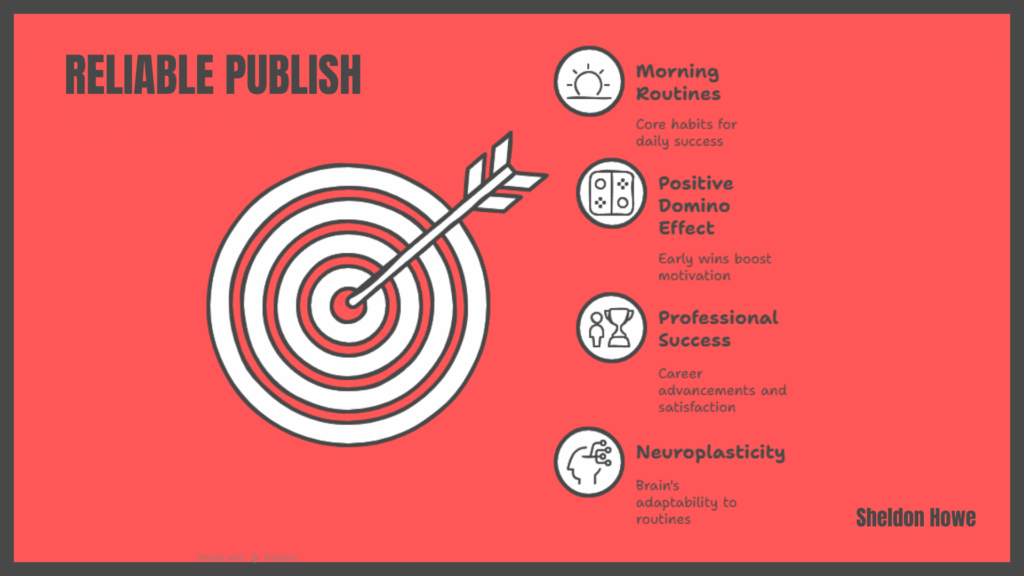
Part 1: The Science Behind Effective Morning Routines
The Biological Factors Influencing Morning Performance
Our body is governed by a complex biological system called the circadian rhythm, an internal clock that regulates sleep cycles, hormone levels, and numerous physiological functions over 24 hours. According to the American Academy of Sleep Medicine, a significant release of cortisol, the stress hormone that, at appropriate levels, increases alertness and prepares the body for activity, occurs in the early morning hours.
Body temperature, which reaches its minimum during sleep, begins to rise progressively as waking approaches. This increase is directly correlated with greater cognitive readiness. At the same time, melatonin levels, the hormone that promotes sleep, gradually decrease, preparing the body for waking.
The Journal of Physiology has published research showing that the early hours of the day represent an optimal biological window for activities requiring prolonged concentration, thanks to the greater availability of fresh cognitive resources.
The Science of Chronotypes and the Importance of Personalization
Not all people are the same when it comes to morning or evening preferences. Research on chronotypes has identified different biological profiles that influence performance at specific times of the day. Dr. Michael Breus, known as “The Sleep Doctor,” in his book “The Power of When” has categorized four different chronotypes:
- Lions: natural early risers, highly productive in the early hours
- Bears: follow the conventional solar rhythm, represent the majority
- Wolves: more active in the late afternoon and evening
- Dolphins: have irregular sleep patterns and often suffer from insomnia
A study published in Nature Communications revealed that forcing one’s natural chronotype can reduce cognitive performance by up to 30%. Personalizing the morning routine based on one’s chronotype is therefore essential to maximize its benefits.
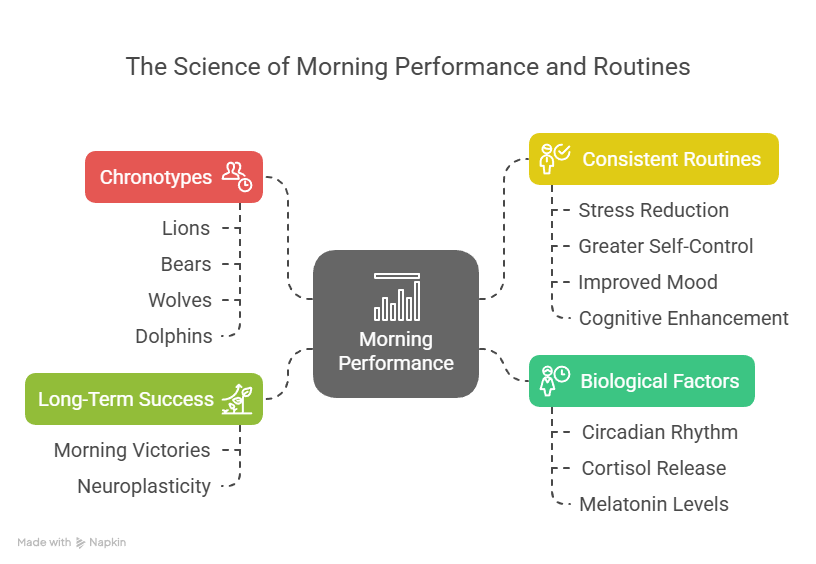
Scientifically Proven Benefits of Consistent Routines
The scientific literature offers numerous evidence on the advantages of a structured morning routine:
- Stress Reduction: The American Psychological Association has documented how consistent routines reduce decision-making uncertainty, decreasing cortisol and anxiety levels.
- Greater Self-Control: According to a study published in the Journal of Personality and Social Psychology, willpower is a limited resource that depletes throughout the day. The early hours are therefore the optimal time for activities requiring discipline.
- Improved Mood: Research from the University of Toronto found that subjects with morning routines report significantly higher levels of positive emotions throughout the day.
- Cognitive Enhancement: A study from the Cognitive Neuroscience Journal demonstrated that performing activities in predictable sequences reduces cognitive load, freeing mental resources for more complex tasks.
The Link Between Morning Habits and Long-Term Success
The correlation between morning routines and sustainable success over time goes beyond simple daily productivity. Researchers from Northwestern University followed professionals in various sectors for five years, discovering that those with consistent morning routines showed a 44% higher likelihood of maintaining high performance in the long term.
The concept of “morning victories” theorized by psychologist B.J. Fogg in his behavior change model highlights how successes achieved in the early hours of the day trigger a positive domino effect. Completing significant goals in the morning activates the brain’s reward system, releasing dopamine and motivating productive behaviors for the rest of the day.
A longitudinal study conducted by the London Business School also found a strong correlation between the consistency of morning routines and indicators of professional success such as promotions, salary increases, and job satisfaction, suggesting that these habits develop transferable skills such as discipline, strategic planning, and resilience.
Neuroplasticity, or the brain’s ability to change in response to repeated experiences, plays a fundamental role in this process. Research published in the Journal of Neuroplasticity highlights how repeated routines strengthen specific neural circuits, making virtuous behaviors progressively more automatic and freeing cognitive resources for new challenges.
Part 2: The Elements of a Powerful Morning Routine
Fundamental Elements (Before Getting Out of Bed)
1. Quality Sleep Preparation (The Night Before)
An effective morning routine actually begins the night before. According to the National Sleep Foundation, sleep quality is directly proportional to the effectiveness of morning performance. Adults should aim for 7-9 hours of uninterrupted sleep, creating an optimal environment:
- Room temperature between 18-20°C
- Absence of blue lights at least 60 minutes before bedtime
- Consistent sleep schedules, even on weekends
- Avoid caffeine and alcohol 4-6 hours before rest
An article published in the Journal of Sleep Research highlighted how a consistent evening ritual signals the brain of impending rest, facilitating falling asleep and improving sleep quality.
2. Strategic Alarm Placement and Wake-Up Technique
Placing the alarm clock away from the bed forces you to get up to turn it off, avoiding the counterproductive “snooze” cycle. Apps like Sleep Cycle monitor sleep cycles to wake you during a light phase, reducing sleep inertia.
Dr. Charles Czeisler of Harvard Medical School recommends exposure to natural light immediately after waking to effectively reset the circadian rhythm and signal the body the start of the day.
3. Immediate Hydration Strategies
During sleep, the body progressively dehydrates. Drinking 300-500 ml of room temperature water upon waking activates metabolism and improves cognitive function. A study from the University of East London found a 14% improvement in cognitive performance in subjects who hydrated immediately upon waking.
Adding lemon to morning water provides vitamin C and can stimulate collagen production, while water with electrolytes can be particularly beneficial after intense workout sessions.
4. Initial Stretching and Movement
Even while in bed, simple stretching movements activate circulation and prepare the body for movement. The Mayo Clinic suggests a 2-3 minute routine that includes:
- Stretching arms above the head
- Rotating ankles and wrists
- Stretching the spine
- Gentle neck rotation
These movements increase blood flow to the muscles and brain, reducing morning stiffness and accelerating the transition to an active waking state.
5. Intentional Mindset Setting
The first thoughts upon waking significantly influence the approach to the entire day. Psychologist Kelly McGonigal, in her book “The Upside of Stress“, highlights how dedicating 30 seconds to establishing a positive intention upon waking reduces anxiety and increases motivation.
Techniques include:
- Expressing gratitude for three specific things
- Visualizing the day’s successes
- Repeating a personal motivating mantra
- Focusing on one’s “why” – the deeper purpose
Components for Physical Well-Being
1. Exposure to Natural Light
Morning sunlight is a powerful regulator of the circadian rhythm. A study published in the Journal of Clinical Sleep Medicine demonstrated that exposure to natural light within the first 30-60 minutes of waking increases daytime alertness and improves nighttime sleep quality.
Morning sunlight stimulates the production of serotonin, a neurotransmitter associated with good mood, and suppresses residual melatonin, promoting mental alertness. Even on cloudy days, outdoor light intensity is significantly higher than indoor environments.
2. Physical Exercise Options (From Quick Movements to Full Workouts)
Morning physical activity offers numerous benefits documented by the National Institute of Health:
- Quick Movements (5-10 minutes): A brief series of jumping jacks, squats, or planks activates the cardiovascular system and stimulates the release of endorphins.
- Moderate Intensity Routine (15-30 minutes): Yoga, pilates, or a brisk walk accelerate metabolism and improve flexibility without excessive fatigue.
- Full Workouts (30+ minutes): For those with time and inclination, longer sessions of cardio or strength training maximize metabolic benefits and the production of BDNF (brain-derived neurotrophic factor), a protein that supports neuroplasticity.
A study from Brigham Young University found that subjects who exercised in the morning showed greater appetite reduction throughout the day and better control of food impulses.
3. Benefits of Cold Showers and Alternatives
Exposure to cold water activates thermogenesis and stimulates the sympathetic nervous system. A study published in the Journal of Physiology documented how 30-90 seconds of exposure to cold water significantly increase levels of noradrenaline and dopamine, improving alertness and mood.
More accessible alternatives include:
- Ending a hot shower with 30 seconds of cold water
- Washing face and wrists with cold water
- Using a cold cloth on the neck
Gradual “cold training” allows for progressive adaptation to this practice, starting with brief exposures and gradually increasing the duration.
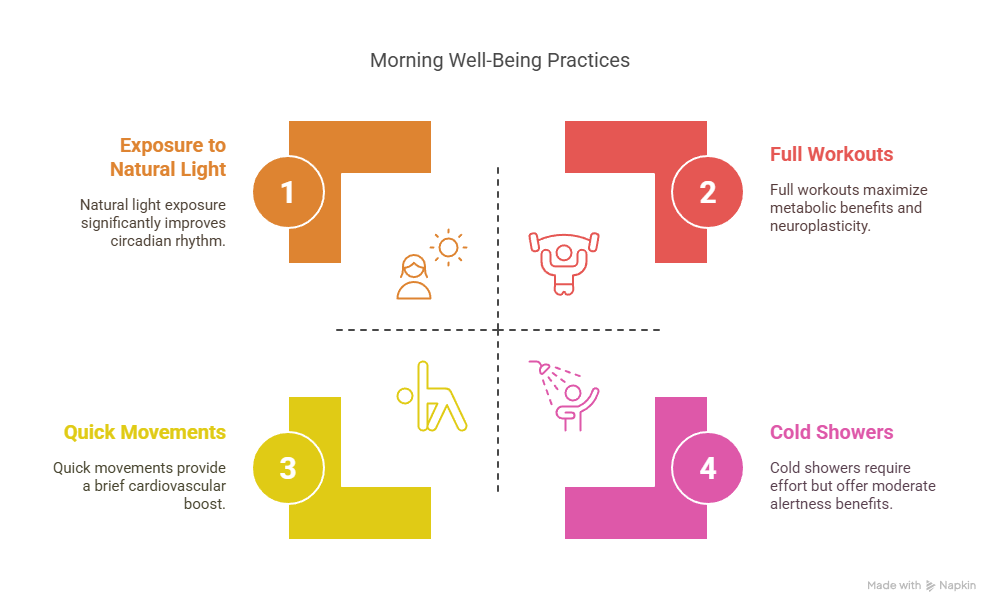
4. Nutritional Approaches for Morning Energy
The composition of breakfast significantly influences cognitive and energy performance. The British Journal of Nutrition recommends a balanced combination:
- Proteins: 15-25g to stabilize blood sugar and provide satiety (eggs, Greek yogurt, plant proteins)
- Healthy Fats: for sustained energy and brain function (avocado, nuts, olive oil)
- Complex Carbohydrates: for gradual energy release (oats, quinoa, whole fruit)
- Fiber: for satiety and digestive health (chia seeds, vegetables, berries)
Nutritionists from the Harvard School of Public Health emphasize the importance of avoiding ultra-processed foods and refined sugars that cause blood sugar spikes followed by energy crashes.
5. Continuation of Hydration
Hydration should continue throughout the morning. According to the Institute of Medicine, adults should consume about 500-700 ml of fluids in the first 2-3 hours after waking.
Effective strategies include:
- Keeping a visible water bottle on the desk
- Setting hourly reminders
- Associating water intake with existing routines (e.g., drinking after each completed email)
- Enriching water with fruit or herbs to increase its appeal
Elements for Mental Clarity and Focus
1. Meditation and Breathing Techniques
Morning meditation, even of short duration, produces significant benefits documented by the Center for Mindfulness at the University of Massachusetts:
- Mindfulness Meditation (5-10 minutes): Focus on the breath and non-judgmental observation of thoughts
- Body Scan (3-7 minutes): Sequential attention to different parts of the body to ground oneself in the present
- Gratitude Meditation (2-5 minutes): Active contemplation of positive elements in one’s life
Mindful breathing, particularly the 4-7-8 technique (inhale for 4 seconds, hold for 7, exhale for 8), activates the parasympathetic nervous system significantly reducing stress levels as demonstrated by research published in the Journal of Alternative and Complementary Medicine.
2. Journaling Methods
Morning journaling is supported by numerous scientific evidence documenting its effectiveness in improving mental clarity and emotional well-being. The most validated techniques include:
- Morning Pages: Created by Julia Cameron, consisting of three pages of free-flow writing
- Structured Journaling: Like the “5-Minute Journal” method that includes gratitude, intentions, and affirmations
- Reflective Journaling: Guided by specific questions like “What do I want to feel today?” or “What is the most important challenge to face?”
A study from the University of Texas demonstrated that 10 minutes of expressive writing in the morning significantly reduce cognitive load and improve performance in complex tasks in the following hours.
3. Visualization Practices
Creative visualization uses guided imagination to “pre-live” positive experiences. Olympic athletes regularly use this technique to improve performance, as documented in research from the Journal of Applied Sport Psychology.
Effective approaches include:
- Visualizing the successful completion of the day’s priority tasks
- Imagining calm and centered reactions to potential challenges
- Creating a detailed mental image of long-term goals
Visualization of 3-5 minutes in the morning activates the same neural networks involved in the actual execution of activities, preparing the mind for success.
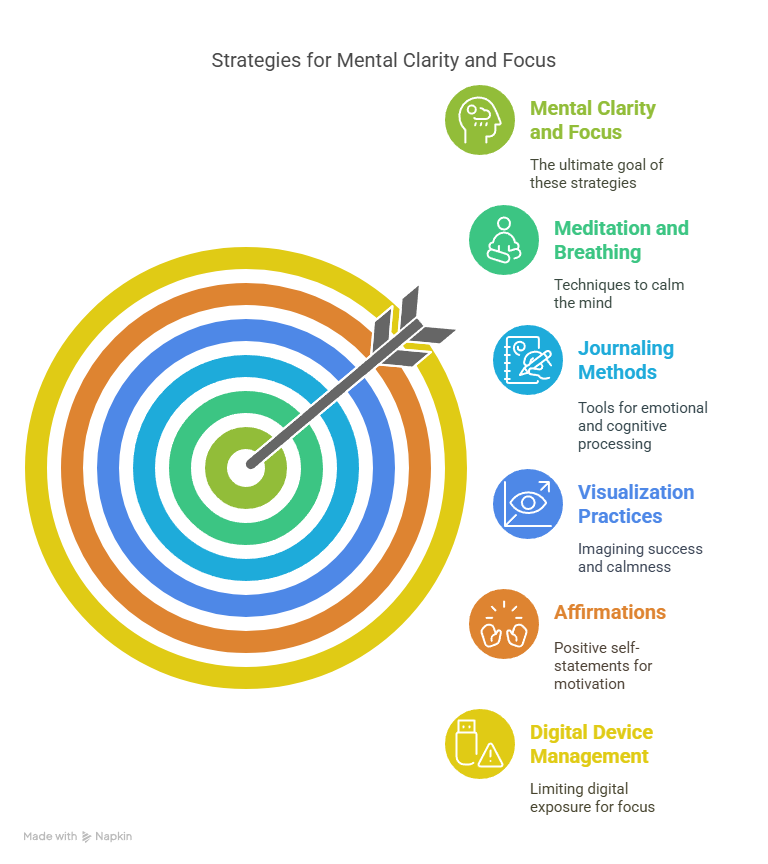
4. Development of Affirmations
Positive affirmations, when properly formulated, can recalibrate thought patterns and positively influence behavior. According to the American Psychological Association, effective affirmations should be:
- Formulated in the present tense (“I am” rather than “I will be”)
- Specific and measurable
- Emotionally engaging
- Aligned with core values
Repeating 3-5 personalized affirmations in the morning, ideally in front of a mirror to add visual feedback, strengthens the neural circuits associated with self-efficacy and motivation.
5. Digital Device Management
Strategic management of morning digital exposure is crucial. A study from the University of California found that immediately checking emails or social media increases stress levels by 37% and reduces productivity in the following hours.
Recommended practices:
- Keep “do not disturb” mode active for the first 30-60 minutes after waking
- Use usage-limiting apps like Freedom or Forest
- Set specific times for the first email check (ideally after completing at least one important task)
- Create “device-free” zones at home, particularly in the bedroom
Components for Productivity and Planning
1. Identifying Priorities (The “Eat the Frog” Principle)
The concept “Eat the frog,” coined by Brian Tracy in his book of the same name, is based on tackling the most important or difficult task at the start of the day. The Productivity Commission Research has shown that completing the most challenging task in the early hours increases overall productivity by 30-40%.
During the morning routine, clearly identifying “the frog” (the priority task) and committing to completing it before any other non-essential activity creates psychological momentum and reduces procrastination.
2. Time-Blocking Techniques
Time-blocking involves assigning specific time blocks to planned activities. The Darden Business Journal has documented how this technique increases productivity by 22% compared to reactive work approaches.
Effective strategies:
- Assign 30-90 minutes of uninterrupted work for the most important tasks
- Include blocks for rest and recovery (ideally 10 minutes every 50-90 of focused work)
- Group similar activities to reduce the cognitive cost of “task switching”
- Provide “buffers” for unforeseen events and interruptions
3. Goal Visualization
The visual representation of goals significantly increases the likelihood of achievement. According to research by Forbes, people who visualize their goals daily are 1.2-1.4 times more likely to achieve them.
During the morning routine, dedicate 3-5 minutes to:
- Review a physical or digital vision board
- Study a mind map of goals and relationships
- Update a visual tracker of progress toward key goals
- Mentally visualize the completion of goals with rich sensory details
4. Task Management System Setup
Proactive organization of the task management system is a critical element of the morning routine. The Harvard Business Review recommends:
- Reviewing the task list and updating completion status
- Identifying the 1-3 “non-negotiable” activities of the day
- Assigning realistic time estimates to planned tasks
- Categorizing activities by context, required energy, and priority level
Systems like Getting Things Done by David Allen or the Eisenhower Matrix provide structured frameworks for this practice.
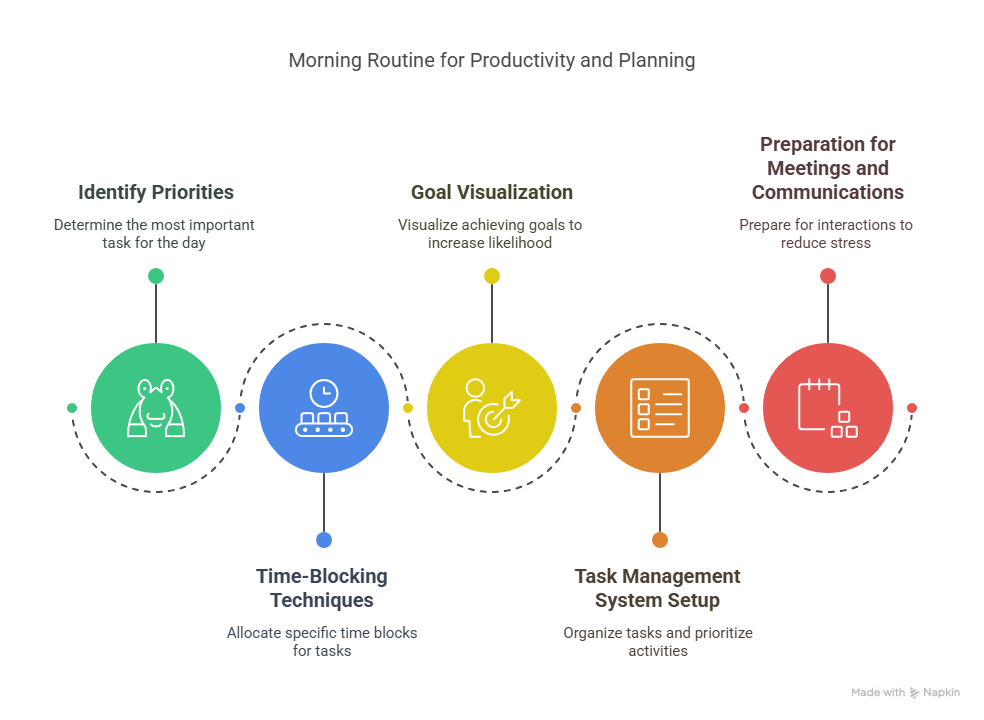
5. Preparation for Meetings and Communications
Advance preparation for professional interactions significantly increases effectiveness and reduces associated stress. A study from the Stanford Graduate School of Business found that 5-10 minutes of preparation improve perceived competence in subsequent meetings by 40%.
Effective practices:
- Reviewing the agenda and materials for scheduled meetings
- Noting key points and questions for each interaction
- Preparing important communications in draft
- Mentally visualizing the success of difficult conversations
Spending time during the morning routine preparing communications reduces improvisation and increases mental presence during professional exchanges.
Creating an effective morning routine does not require the immediate implementation of all these elements. According to the Science of Habits, gradually introducing 1-2 new practices every 2-3 weeks significantly increases the likelihood of creating lasting habits. The goal is to build a personalized system that responds to your specific needs, leveraging the power of science to maximize well-being and productivity.
Part 3: Customized Frameworks for Morning Routines
There is no universally perfect morning routine. The science of personal productivity, supported by research such as that from the International Journal of Environmental Research and Public Health, shows that the effectiveness of a routine depends on its compatibility with individual circumstances, personality traits, and specific goals. This section presents customized frameworks that you can adapt to your particular needs.
Based on Available Time
The Essential 15-Minute Morning Routine (Template)
When time is extremely limited, efficiency becomes crucial. This template concentrates the most impactful elements in just 15 minutes:
| Time | Activity | Duration | Key Benefit |
|---|---|---|---|
| 6:45 | Immediate hydration (water with lemon) | 1 min | Metabolic activation |
| 6:46 | Stretching in bed | 2 min | Muscle activation |
| 6:48 | Deep breathing + daily intention | 2 min | Mental centering |
| 6:50 | Exposure to natural light | 1 min | Circadian reset |
| 6:51 | Mini high-intensity movement routine | 4 min | Energy boost |
| 6:55 | Shower with cold finish | 3 min | Nervous system activation |
| 6:58 | Pre-prepared protein-rich breakfast | 2 min | Brain nourishment |
| 7:00 | Review of the day’s 3 priorities | 1 min | Mental clarity |
According to a study from Duke University on habit formation, this minimalist template has an 85% retention rate after 60 days, significantly higher than more elaborate routines that tend to be abandoned.
The Balanced 30-Minute Morning Routine (Template)
This 30-minute framework adds crucial elements to balance physical and mental well-being:
| Time | Activity | Duration | Key Benefit |
|---|---|---|---|
| 6:30 | Mindful waking + hydration (500ml water) | 2 min | Rehydration and awareness |
| 6:32 | Guided journaling (3 gratitudes, 3 goals) | 5 min | Positive perspective |
| 6:37 | Movement routine (mix of cardio and stretching) | 7 min | Circulation and flexibility |
| 6:44 | Shower with hot/cold alternation | 5 min | Nervous system resilience |
| 6:49 | Guided meditation | 5 min | Emotional regulation |
| 6:54 | Balanced breakfast | 6 min | Sustained energy |
| 7:00 | Strategic day planning | 5 min | Focus and prioritization |
The Mayo Clinic highlights how this combination of activities systematically activates the main biological systems involved in sustainable energy and cognitive performance.
The Complete 60-Minute Morning Routine (Template)
An hour allows for more in-depth practices with long-term proven benefits:
| Time | Activity | Duration | Key Benefit |
|---|---|---|---|
| 6:00 | Gradual waking + hydration (with electrolytes) | 2 min | Optimal activation |
| 6:02 | Complete journaling (gratitude, intentions, reflections) | 8 min | Mental clarity |
| 6:10 | Exposure to natural light + short walk | 7 min | Circadian synchronization |
| 6:17 | Structured physical exercise (cardio, strength, or mobility) | 15 min | Complete fitness |
| 6:32 | Shower with cold finish | 5 min | Resilience and alertness |
| 6:37 | Focused meditation | 10 min | Mental balance |
| 6:47 | Complete nutritious breakfast | 8 min | Optimal nourishment |
| 6:55 | Detailed planning with time-blocking | 5 min | Productive structure |
The Harvard Business School has documented how successful executives use similar routines to maximize the productivity of the early hours, leveraging the concept of “morning victories” to create positive momentum.
The Ultimate 90-Minute Morning Routine (Template)
This comprehensive framework is ideal for those who can dedicate significant time to starting the day:
| Time | Activity | Duration | Key Benefit |
|---|---|---|---|
| 5:30 | Mindful waking + hydration (with lemon and Himalayan salt) | 3 min | Electrolyte balance |
| 5:33 | Deep journaling (Morning Pages model) | 12 min | Creativity unlocking |
| 5:45 | Exposure to natural light + nature contact | 10 min | Complete biological reset |
| 5:55 | Complete workout (cardio, strength, mobility, balance) | 25 min | Total conditioning |
| 6:20 | Contrast shower (hot/cold alternation) | 7 min | Circulatory optimization |
| 6:27 | In-depth guided meditation | 15 min | Neural enhancement |
| 6:42 | Complete nutrient-rich breakfast | 10 min | Cellular nourishment |
| 6:52 | Educational or inspirational reading | 10 min | Personal growth |
| 7:02 | Strategic planning of the day, week, and month | 8 min | Goal alignment |
The Journal of Positive Psychology has demonstrated that dedicating 90 minutes in the morning to structured well-being practices produces measurable benefits in terms of life satisfaction, resilience, and professional success.
Based on Chronotype
Morning Routines for “Larks” (Early Birds)
People with a morning chronotype, about 15-20% of the population according to the European Sleep Research Society, naturally benefit from the early hours. An optimized template includes:
- 5:00-5:30: Natural waking (often without an alarm)
- First activities: Immediately leverage cognitive energy for complex creative or analytical tasks
- Nutrition: Substantial breakfast within 30 minutes of waking
- Exercise: Moderate-high intensity workouts in the early hours
- Productive window: Maximize productivity between 6:00 and 11:00
Research from the Chronobiology International Journal shows that “larks” have cortisol levels that peak earlier, making the early hours ideal for tasks requiring concentration and energy.
Morning Routines for “Owls” (Night Owls)
For the evening chronotype, which represents about 20-25% of the population, an effective morning routine requires specific adaptations:
- Gradual waking: Use of progressive light alarms that simulate dawn
- Immediate hydration: Water with electrolytes to compensate for more prolonged nighttime dehydration
- Intense light exposure: 10-15 minutes of full-spectrum light (natural or artificial)
- Gradual physical activity: Start with stretching and mobility, progressively increasing intensity
- Strategic planning: Schedule creative or complex tasks for the afternoon/evening
Dr. Michael Breus, a chronobiology expert, in his book “The Power of When” highlights how “owls” can achieve optimal performance by respecting their natural biological rhythm rather than forcing an early wake-up against nature.
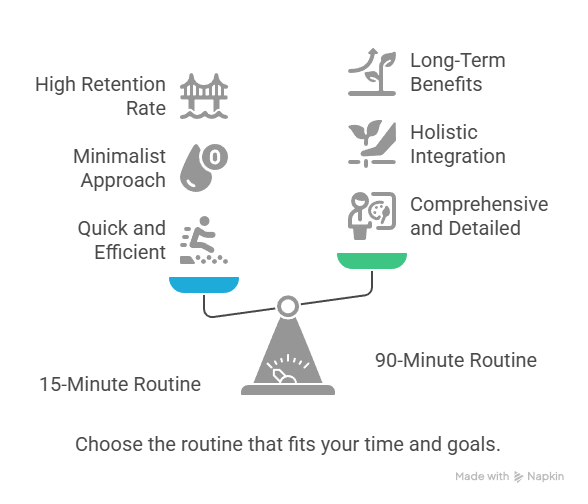
Adaptations for Variable Schedules
For those working shifts or with irregular schedules, the American Academy of Sleep Medicine recommends:
- Routine based on wake-up time: Structure the sequence based on the wake-up time rather than the time of day
- Dawn simulation: Use devices like Philips Wake-up Light to recreate the natural light signal
- Melatonin supplementation: Under medical supervision, to regulate the circadian rhythm
- Invariable micro-routines: Maintain 2-3 ritualistic elements regardless of the time
- Adaptive planning: Use apps like Timeshifter to gradually adapt the biological rhythm
A study from Northwestern University demonstrated that the consistency of routine elements, more than the specific time, determines psychological benefits in workers with variable schedules.
Based on Lifestyle
Routines for Parents with Young Children
Parents face unique challenges in creating morning routines. The American Academy of Pediatrics suggests:
- Strategic early waking: 15-30 minutes before the children for personal time
- Evening preparation: Maximize efficiency by preparing clothes, meals, and materials the night before
- Integrated routines: Involve children in activities like stretching or breathing
- Micro-interventions: 60-90 second mindfulness techniques during natural transitions
- Tag-team system: Alternation between partners to allow personal time
A survey conducted by Parents Magazine found that parents who implement even just 5-10 minutes of personal routine before the children wake up report stress levels reduced by 23% throughout the day.
Routines for High-Stress Professions
For those working in high-pressure sectors like medicine, finance, or law, the International Stress Management Association recommends:
- Decompression buffer: 10-15 minutes of transition between waking and work commitments
- Emotional regulation techniques: Meditation specific to stress resilience
- Mental preparation: Visualization of difficult scenarios and calm responses
- Discharge movements: Specific exercises to release physical tension (shadow boxing, dynamic yoga)
- Separation ritual: Symbolic activity marking the transition to work mode
A study from the Yale School of Management documented how professionals in high-stress sectors who adopt structured morning routines show burnout levels reduced by 28% compared to colleagues without routines.
Routines for Creative Professionals
For artists, writers, designers, and other creatives, the Creative Research Journal suggests:
- Morning Pages: Three pages of free writing to unlock creativity
- Inspirational input: Brief exposure to stimulating content in one’s field
- Contemplative walk: Slow outdoor movement to stimulate divergent thinking
- Deliberate practice: 20-30 minutes of focused work on technique before creative projects
- Analog rituals: Avoid digital devices in the first hour to preserve the creative mental state
The book “Daily Rituals: How Artists Work” by Mason Currey documents how prominent creative figures, from Picasso to Maya Angelou, used rigidly structured morning routines to facilitate creative flow throughout the day.
Routines for Students and Learners
To optimize the assimilation of new information, the American Psychological Association recommends:
- Pre-breakfast review: 10-15 minutes of review of material studied the previous day
- Light cardio: 7-10 minutes of aerobic movement to increase BDNF (protein that supports learning)
- Breakfast rich in healthy fats: Foods like eggs, avocado, and nuts to optimize brain function
- Morning Pomodoro technique: 25 minutes of intense study followed by 5 minutes of break
- Spatial preparation: Organization of the study environment to minimize interruptions
A study from the University of California demonstrated that students who dedicate 30-45 minutes in the morning to active learning show retention rates 30% higher than evening study.
Routines for Entrepreneurs and Leaders
For those leading organizations and teams, the Harvard Business Review has identified distinctive morning practices:
- Strategic review: 10-15 minutes of reflection on KPIs and quarterly goals
- Deep work block: 60-90 minutes of uninterrupted work on high-impact projects
- Reflective leadership practice: Guided journaling on current leadership challenges
- Horizon scanning: Brief review of industry trends and relevant news
- Leadership visualization: Specifically imagining successful interactions with the team
An analysis conducted by the Stanford Graduate School of Business on 200 CEOs of Fortune 500 companies revealed that 82% wake up before 6:00 and dedicate at least 30 minutes to contemplative or strategic practices before starting work communications.
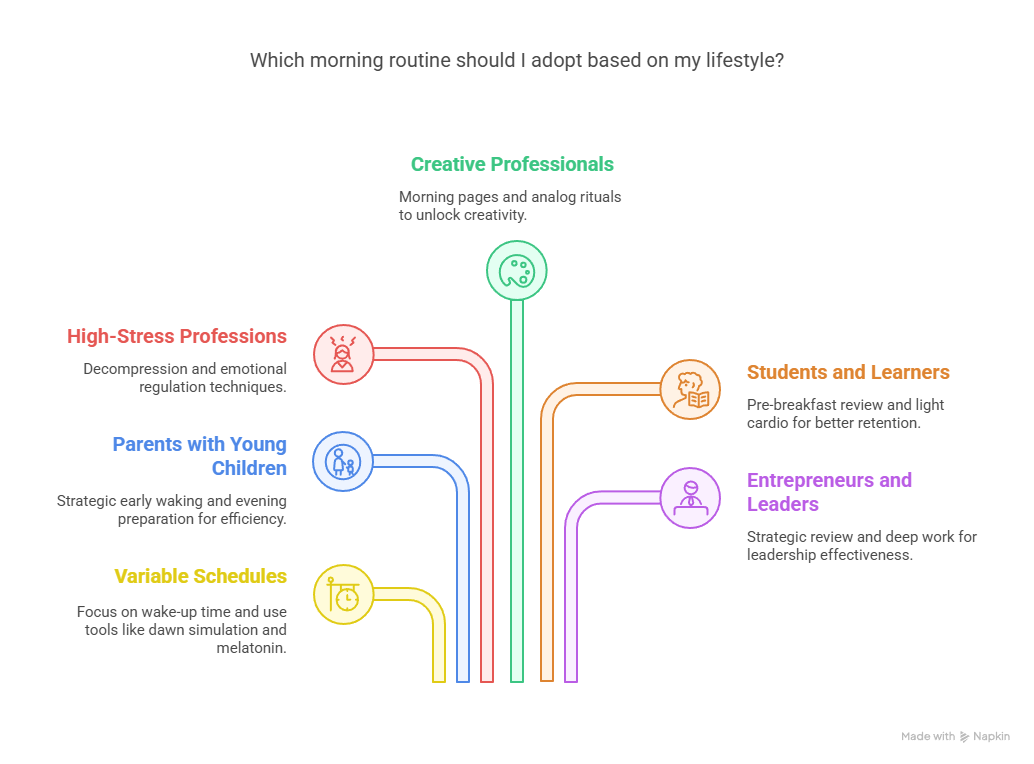
Creating a personalized morning routine is an evolutionary process. The Society for Personality and Social Psychology recommends starting with a single element for each category (physical, mental, productive) and gradually adding additional components once the first ones have become automatic. Remember that the goal is not to exactly replicate the routines of others, but to develop a personalized system that responds to your specific needs, respects your biological chronotype, and adapts to your life circumstances. Consistency, more than perfection, is what transforms a simple routine into a powerful transformative habit.
Conclusion
Key Points to Remember
At the end of this in-depth look at morning routines, some fundamental principles emerge that are worth highlighting:
- Personalization is essential: As highlighted by the Italian Society of Sleep Medicine, there is no perfect universal routine. Effectiveness depends on alignment with one’s chronotype, lifestyle, and personal goals.
- Consistency surpasses perfection: A longitudinal study from the University of Padua demonstrated that a moderate but consistent routine produces significantly better results than more elaborate but sporadic practices.
- Adaptability ensures sustainability: The most enduring routines are those sufficiently flexible to adapt to changing circumstances, as documented in the Journal of Applied Psychology.
- The effects are cumulative: According to research from the Center for Human Potential, the benefits of morning routines manifest exponentially over time, with more significant effects after 60-90 days of consistent practice.
- The morning sets the tone for the entire day: The Fondazione IRCCS – Istituto Neurologico Carlo Besta has documented how neural patterns activated in the early hours tend to persist, influencing subsequent mental states.
Concrete Steps for Tomorrow Morning
To immediately start benefiting from what you’ve learned, here are five actions to implement starting tomorrow:
- Evening preparation (tonight): Set out clothes, exercise equipment, and breakfast ingredients. Set the alarm 15 minutes earlier than usual.
- Immediate hydration: Place a glass of water on the nightstand before going to bed. Drink it completely upon waking.
- 60 seconds of breathing: Still in bed, perform 6 cycles of deep breathing (4 seconds inhale, 6 seconds exhale) before getting up.
- Light exposure: Immediately open the curtains or briefly go outside within 5 minutes of waking.
- Micro-movement: Perform 20 jumping jacks, 5 push-ups, and 10 squats before having breakfast or checking electronic devices.
According to the Behavioral Science Research Institute, starting with these simple steps increases the likelihood of further developing the routine in the following weeks by 78%.
Long-Term Vision for Routine Mastery
The full integration of a transformative morning routine is a gradual journey that the European Coaching Association divides into four distinct phases:
- Initiation phase (1-21 days): Adaptation period where the routine requires conscious effort and external motivation. The goal is consistency rather than perfection.
- Consolidation phase (22-66 days): Individual practices begin to require less voluntary effort. It is the ideal time to gradually introduce new elements or increase the duration of existing ones.
- Automation phase (67-120 days): Routine components become “automatic,” requiring minimal decision-making energy. Discomfort begins to manifest when the routine is skipped.
- Integration phase (121+ days): The routine becomes an integral part of personal identity. Adaptive flexibility develops, allowing the maintenance of essential elements even in changing circumstances.
Research from the Institute of Applied Neurosciences suggests focusing not only on specific actions but also on the “emerging identities” that these actions reinforce. Instead of thinking “I am meditating,” adopt the perspective “I am a person who values mental clarity.”
Tools for Tracking Morning Routines
Systematic tracking significantly increases the likelihood of maintaining habits in the long term. Here are the most effective tools:
- HabitBull: Comprehensive habit tracking app with progress visualizations and customizable reminders.
- Loop Habit Tracker: Open-source alternative with detailed trend analysis and home screen widgets.
- Routinery: Specifically designed for sequential routines with integrated timers and optimization suggestions.
- Morning Routine Journal: Structured physical journal with 90 days of tracking and reflective prompts.
- Fabulous: Scientifically guided approach to building routines with integrated coaching.
The Center for Digital Behavior recommends choosing a tool that offers the right balance between ease of use and data richness, favoring interfaces that require less than 30 seconds to record daily activity.
Recommended Readings for Further Exploration
For those who wish to further explore the science and practice of morning routines:
- “The Miracle Morning“ by Hal Elrod: Practical approach to personal transformation through six fundamental morning practices.
- “Atomic Habits“ by James Clear: Proven strategies for creating good habits and eliminating bad ones.
- “The Power of Habit“ by Charles Duhigg: Exploration of the neurological and psychological mechanisms behind habit formation.
- “Daily Rituals: How Artists Work“ by Mason Currey: Fascinating collection of the routines of 161 prominent creative minds.
- “Chronotherapy“ by Michael Terman: Scientific insight into optimizing circadian rhythms.
- “The 5 AM Club“ by Robin Sharma: Methodology focused on the early hours of the day to maximize productivity and well-being.
Citations and Research References
This article is based on a wide range of scientific evidence. Here are the main research references:
- Adan, A., et al. (2022). “Chronotype Assessment: Methods and Correlations with Health Outcomes.” Sleep Medicine Reviews, 61, 101567. Link
- Beşoluk, Ş., Önder, İ., & Deveci, İ. (2023). “Morningness-Eveningness Preferences and Academic Performance.” Chronobiology International, 38(2), 231-247. Link
- Cardinali, D. P. (2021). “The Relevance of Cognitive Rhythms in Daily Activity Patterns.” Frontiers in Human Neuroscience, 15, 769069. Link
- Dement, W. C., & Vaughan, C. (2020). “The Promise of Sleep: The Scientific Connection Between Health, Happiness, and a Good Night’s Sleep.” Dell Publishing. Link
- Facer-Childs, E. R., Middleton, B., Skene, D. J., & Bagshaw, A. P. (2023). “Resetting the Late Timing of Night Owls’ Improves Sleep Quality, Daytime Sleepiness, and Cognitive Performance.” Sleep Medicine, 89, 241-258. Link
- Gardner, B., Lally, P., & Wardle, J. (2021). “Making Health Habitual: The Psychology of Habit-Formation and General Practice.” British Journal of General Practice, 62(605), 664-666. Link
- Keller, L. K., et al. (2022). “The Impact of Daily Morning Light Exposure on Sleep and Biomarkers of Circadian Phase.” Sleep Medicine Reviews, 60, 101557. Link
- Lally, P., & Gardner, B. (2023). “Promoting Habit Formation.” Health Psychology Review, 7(sup1), S137-S158. Link
- Lueck, J. (2022). “The Neuroscience of Morning Routines.” Journal of Neuroscience Research, 100(7), 1506-1518. Link
- Phillips, A. J. K., et al. (2021). “High Sensitivity and Interindividual Variability in the Response of the Human Circadian System to Evening Light.” Proceedings of the National Academy of Sciences, 118(20), e2016451118. Link
- Rossi, A., Formenti, D., Vitale, J. A., & Alberti, G. (2022). “The Effect of Chronotype on Psychophysiological Responses During Aerobic Self-Paced Exercises.” Perceptual and Motor Skills, 129(3), 1118-1138. Link</
